Hellenic World › Alexandria, Egypt » Ancient origins
Articles and Definitions › Contents
- Hellenic World › Antique Origins
- Alexandria, Egypt › Ancient History
Ancient civilizations › Historical and archaeological sites
Hellenic World › Antique Origins
Definition and Origins
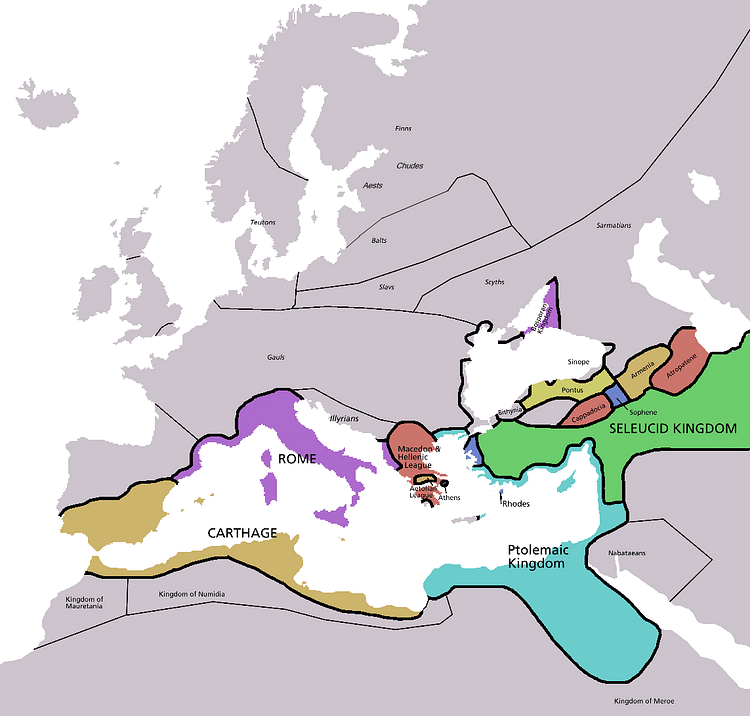
'The Hellenic World ' is a term which refers to that period of ancient Greek history between 507 BCE (the date of the first democracy in Athens ) and 323 BCE (the death of Alexander the Great ). This period is also referred to as the age of Classical Greece and should not be confused with The Hellenistic World which designates the period between the death of Alexander and Rome 's conquest of Greece (323 - 146 - 31 BCE). The Hellenic World of ancient Greece consisted of the Greek mainland, Crete, the islands of the Greek archipelago, and the coast of Asia Minor primarily (though mention is made of cities within the interior of Asia Minor and, of course, the colonies in southern Italy ). This is the time of the great Golden Age of Greece and, in the popular imagination, resonates as 'ancient Greece'.
The great law-giver, Solon, having served wisely as Archon of Athens for 22 years, retired from public life and saw the city, almost immediately, fall under the dictatorship of Peisistratus. Though a dictator, Peisistratus understood the wisdom of Solon, carried on his policies and, after his death, his son Hippias continued in this tradition (though still maintaining a dictatorship which favored the aristocracy). After the assassination of his younger brother (inspired, according to Thucydides, by a love affair gone wrong and not, as later thought, politically motivated), however, Hippias became wary of the people of Athens, instituted a rule of terror, and was finally overthrown by the army under Kleomenes I of Sparta and Cleisthenes of Athens.Cleisthenes reformed the constitution of Athens and established democracy in the city in 507 BCE. He also followed Solon's lead but instituted new laws which decreased the power of the artistocracy, increased the prestige of the common people, and attempted to join the separate tribes of the mountan, the plain, and the shore into one unified people under a new form of government. According to the historian Durant, "The Athenians themselves were exhilarated by this adventure into sovereignty. From that moment they knew the zest of freedom in action, speech, and thought; and from that moment they began to lead all Greece in literature and art, even in statesmanship and war " (126). This foundation of democracy, of a free state comprised of men who "owned the soil that they tilled and who ruled the state that governed them", stabilized Athens and provided the groundwork for the Golden Age.
THE GOLDEN AGE OF GREECE, ACCORDING TO THE POET SHELLEY, "IS UNDOUBTEDLY...THE MOST MEMORABLE IN THE HISTORY OF THE WORLD".
The list of thinkers, writers, doctors, artists, scientists, statesmen, and warriors of the Hellenic World comprises those who made some of the most important contributions to western civilization : The statesman Solon, the poets Pindar and Sappho, the playwrights Sophocles, Euripedes, Aeschylus and Aristophanes, the orator Lysias, the historians Herodotus and Thucydides, the philosophers Zeno of Elea, Protagoras of Abdera, Empedocles of Acragas, Heraclitus, Xenophanes, Socrates, Plato, and Aristotle, the writer and general Xenophon, the physician Hippocrates, the sculptor Phidias, the statesman Pericles, the generals Alcibiades and Themistocles, among many other notable names, all lived during this period. The Golden Age of Greece, according to the poet Shelley, "is undoubtedly...the most memorable in the history of the world" for the accomplishments and advancements made by the people of that time. Interestingly, Herodotus considered his own age as lacking in many ways and looked back to a more ancient past for a paradigm of a true greatness. The writer Hesiod, an 8th century BCE contemporary of Homer, claimed precisely the same thing about the age Herodotus looked back toward and called his own age "wicked, depraved and dissolute" and hoped the future would produce a better breed of man for Greece. Herodotus aside, however, it is generally understood that the Hellenic World was a time of incredible human achievement.
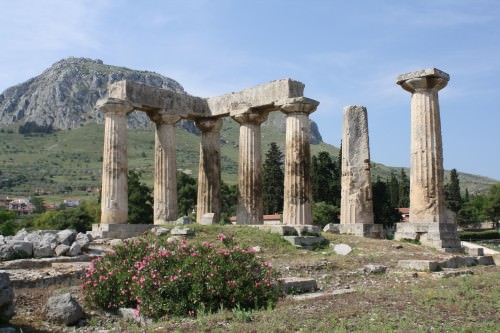
Monolithic Columns, Corinth
Major city-states (and sacred places of pilgrimage) in the Hellenic World were Argos, Athens, Eleusis, Corinth, Delphi, Ithaca, Olympia, Sparta, Thebes, Thrace, and, of course, Mount Olympus, the home of the gods. The gods played an important part in the lives of the people of the Hellenic World; so much so that one could face the death penalty for questioning - or even allegedly questioning - their existence, as in the case of Protagoras, Socrates, and Alcibiades (the Athenian statesman Critias, sometimes referred to as `the first atheist', only escaped being condemned because he was so powerful at the time). Great works of art and beautiful temples were created for the worship and praise of the various gods and goddesses of the Greeks, such as the Parthenon of Athens, dedicated to the goddess Athena Parthenos (Athena the Virgin) and the Temple of Zeus at Olympia (both works which Phidias contributed to and one, the Temple of Zeus, listed as an Ancient Wonder). The temple of Demeter at Eleusis was the site of the famous Eleusinian Mysteries, considered the most important rite in ancient Greece. In his works The Iliad and The Odyssey, immensely popular and influential in the Hellenic World, Homer depicted the gods and goddesses as being intimately involved in the lives of the people, and the deities were regularly consulted in domestic matters as well as affairs of state. The famous Oracle at Delphi was considered so important at the time that people from all over the known world would come to Greece to ask advice or favors from the god, and it was considered vital to consult with the supernatural forces before embarking on any military campaign.
Among the famous battles of the Hellenic World that the gods were consulted on were the Battle of Marathon (490 BCE) the Battles of Thermopylae and Salamis (480 BCE), Plataea (479 BCE,) and The Battle of Chaeronea (338 BCE) where the forces of the Macedonian King Philip II commanded, in part, by his son Alexander, defeated the Greek forces and unified the Greek city-states. After Philip's death, Alexander would go on to conquer the world of his day, becoming Alexander the Great.Through his campaigns he would bring Greek culture, language, and civilization to to the world and, after his death, would leave the legacy which came to be known as the Hellenistic World.
Alexandria, Egypt › Ancient History
Definition and Origins
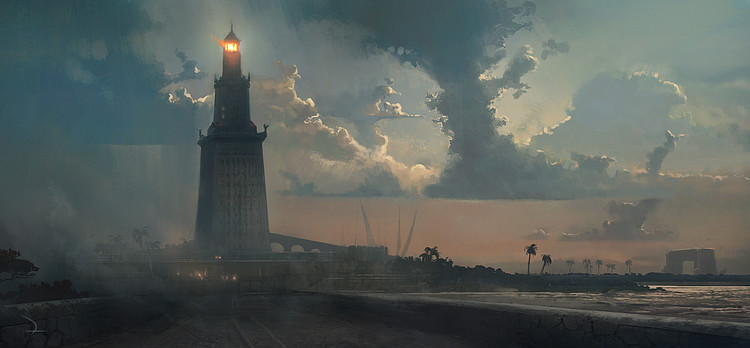
Alexandria is a port city located on the Mediterranean Sea in northern Egypt founded in 331 BCE by Alexander the Great.It is most famous in antiquity as the site of the Pharos, the great lighthouse, considered one of the seven wonders of the ancient world, for the Temple of Serapis, the Serapion, which was part of the legendary library at Alexandria, as a seat of learning and, once, the largest and most prosperous city in the world. It also became infamous for the religious strife which resulted in the martyrdom of the philosopher Hypatia of Alexandria in 415 CE. The city grew from a small port town to become the grandest and most important metropolis in ancient Egypt.
FOUNDATION BY ALEXANDER
After conquering Syria in 332 BCE, Alexander the Great swept down into Egypt with his army. He founded Alexandria in the small port town of Rhakotis by the sea and set about the task of turning it into a great capital. It is said that he designed the plan for the city which was so greatly admired later by the historian Strabo (63 BCE-21CE) who wrote,
The city has magnificent public precincts and royal palaces which cover a fourth or even a third of the entire area. For just as each of the kings would, from a love of splendour, add some ornament to the public monuments, so he would provide himself at his own expense with a residence in addition to those already standing.
ALEXANDRIA ATTRACTED SCHOLARS, SCIENTISTS, PHILOSOPHERS, MATHEMATICIANS, ARTISTS, & HISTORIANS.
The palaces and grand homes Strabo mentions did not exist at the time Alexander founded the city. Although he was greatly admired by the Egyptians (and was even declared a demi-god by the Oracle at Siwa), Alexander left Egypt only a few months after his arrival to march on Tyre in Phoenicia. It was left to his commander, Cleomenes, to build the city Alexander had envisioned. While Cleomenes accomplished a great deal, the full expansion of Alexandria came under the rule of Alexander's general Ptolemy and the rule of the Ptolemaic Dynasty (332-30 BCE) which followed. After Alexander's death in 323 BCE, Ptolemy brought his body back to Alexandria to be entombed and, following the wars of the Diodachi, began rule of Egypt from Alexandria, supplanting the old capital of Memphis. Tyre had been an important city for trade and commerce in the region and, after its destruction by Alexander, Alexandria filled the void which had been left. Carthage (which largely became so prosperous owing to the sack of Tyre) was still a young port town when Alexandria began to thrive. The historian and scholar Mangasarian writes,
“Under the Ptolemies, a line of Greek kings, Alexandria soon sprang into eminence, and, accumulating culture and wealth, became the most powerful metropolis of the Orient. Serving as the port of Europe, it attracted the lucrative trade of India and Arabia. Its markets were enriched with the gorgeous silks and fabrics from the bazaars of the Orient. Wealth brought leisure, and it, in turn, the arts. It became, in time, the home of a wonderful library and schools of philosophy, representing all the phases and the most delicate shades of thought. At one time it was the general belief that the mantle of Athens had fallen upon the shoulders of Alexandria.

Gold Octadrachm of Ptolemy II & Arsinöe II
The city grew to become the largest in the known world at the time, attracting scholars, scientists, philosophers, mathematicians, artists, and historians. Eratosthenes (c.276-194 BCE) calculated the circumference of the earth to within 50 miles (80 km) at Alexandria. Euclid taught at the university there. Archimedes (287-212 BCE) the great mathematician and astronomer may have taught there and was certainly studied there. The greatest engineer and mathematician of his day, Hero (also known as Heron, 10-70 CE) was born and lived in Alexandria. Hero was credited with amazing feats in engineering and technology including the first vending machine, the force-pump, and a theatre of automated figures who danced, among his other inventions.
THE LIBRARY OF ALEXANDRIA WAS COMPLETED BY PTOLEMY II (285-246 BCE) WHO SENT INVITATIONS TO RULERS AND SCHOLARS ASKING THEM TO CONTRIBUTE BOOKS.
THE LIBRARY OF ALEXANDRIA
The library, begun under Ptolemy I (305-285 BCE) was completed by Ptolemy II (285-246 BCE) who sent invitations to rulers and scholars asking them to contribute books. According to historians Oakes and Gahlin, “There was room for up to 70,000 papyrus scrolls. Most of the items were bought but other means were sometimes used. In order to procure coveted works, all ships entering the harbour were searched. Every book found was taken to the Library where it was decided whether to give it back or confiscate it and replace it with a copy” (230). No one knows how many books were held in the library at Alexandria but estimates have been made of 500,000. It is said that Mark Antony gave Cleopatra 200,000 books for the library but this claim has been disputed since antiquity. Mangasarian writes,
After its magnificent library, whose shelves supported a freight more precious than beaten gold, perhaps the most stupendous edifice in the town was the temple of Serapis. It is said that the builders of the famous temple of Edessa boasted that they had succeeded in creating something which future generations would compare with the temple of Serapis in Alexandria. This ought to suggest an idea of the vastness and beauty of the Alexandrian Serapis, and the high esteem in which it was held. Historians and connoisseurs claim it was one of the grandest monuments of Pagan civilization, second only to the temple of Jupiter in Rome, and the inimitable Parthenonin Athens. The Serapis temple was built upon an artificial hill, the ascent to which was by a hundred steps. It was not one building, but a vast body of buildings, all grouped about a central one of vaster dimensions, rising on pillars of huge magnitude and graceful proportions. Some critics have advanced the idea that the builders of this masterpiece intended to make it a composite structure, combining the diverse elements of Egyptian and Greek art into a harmonious whole. The Serapion was regarded by the ancients as marking the reconciliation between the architects of the pyramids and the creators of the Athenian Acropolis. It represented to their minds the blending of the massive in Egyptian art with the grace and the loveliness of the Hellenic.
When Carthage rose to the height of her power, Alexandria was relatively unaffected as trade had long been established and the city posed no threat to the sea power of the Carthaginians. Even after the fall of Carthage following the Punic Wars (264-146 BCE), when Rome became supreme and Alexandria fell under her sway, the city remained prosperous and continued to attract visitors from all over the world. The increasing tensions in Rome between Julius Caesar and Pompey first impacted Alexandria negatively in 48 BCE. Prior to this date, though the city certainly experienced its share of problems, it remained a stable environment. Following the Battle of Pharsalus, however, at which Caesar defeated Pompey, Pompey fled to Alexandria seeking sanctuary and was killed by the co-regent Ptolemy XIII. Caesar arrived and, whether real or feigned, claimed outrage at the death of his former friend and ally. He then declared martial law, took over the royal palace, and sent for the exiled co-regent Cleopatra VII. In the civil war which ensued much of Alexandria was burned including, according to some scholars, the famous library.
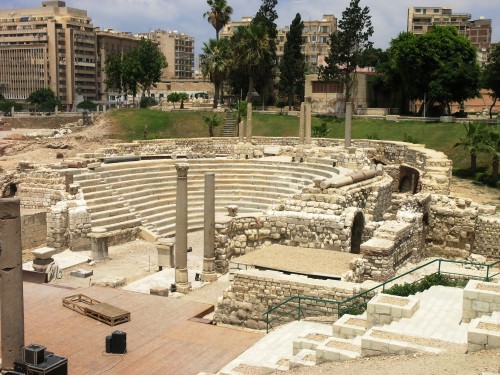
Roman Theatre, Alexandria
ROMAN ALEXANDRIA
Following Caesar's assassination in 44 BCE, his right-hand man, Marcus Antonius (Mark Antony ) became Cleopatra's consort and left Rome for Alexandria. The city became his base of operations over the next thirteen years until he and Cleopatra were defeated by Octavian Caesar at the Battle of Actium in 31 BCE. The next year, Cleopatra and Antony both committed suicide and, with her death, the Ptolemaic line came to an end. Octavian became first emperor of Rome and took the title ` Augustus '. Alexandria now became a simple province of the Roman Empire under the rule of Augustus Caesar.
Augustus consolidated his power in the provinces and had Alexandria restored. Scholars who argue against Julius Caesar's role in the burning of the great library point to the fact that there is evidence it was still extant under the reign of Augustus and that visitors were still attracted to the city as a seat of learning. Alexandria was again ruined in 115 CE in the Kitos War and was again restored, this time by the Emperor Hadrian, who, as a man of learning, took great interest in Alexandria. According to tradition, the Greek Septuagint (the Greek translation of the Bible ) was composed in Alexandria, completed in 132 CE, in order that it could take its place among the great books of the library in the city. Religious scholars were said to frequent the library for research and Alexandria had long attracted people of many different faiths who vied for dominance in the city. Under Augustus' reign there were disputes between Jews and pagans and, as Christianity grew in popularity, the Christians added to the public unrest. After the Roman emperor Constantine the Great (272-337 CE) passed the Edict of Milan in 313 CE (decreeing religious tolerance), Christians were no longer liable for prosecution under the law and began to not only demand more religious rights, but more vociferously attack the pagans and the Jews.
CHRISTIANITY & THE DECLINE OF ALEXANDRIA
Alexandria, which had been a city of prosperity and learning, became an arena of religious contention between the new faith of the Christians and the old faith of the pagan majority. The Christians increasingly felt bold enough to strike at the symbols of the old faith in an attempt to topple it. Magasarian writes,
It is not so much religion that makes the character of a people, as it is the people who determine the character of their religion. Religion is only the resume of the national ideas, thoughts, and character. Religion is nothing but an expression. It is not, for instance, the word or the language which creates the idea, but the idea which provokes the word into existence. In the same way religion is only the expression of a people's mentality. And yet a man's religion or philosophy, while it is but the product of his own mind, exerts a reflex influence upon his character. The child influences the parent, of whom it is the offspring; language affects thought, of which, originally, it was but the tool. So it is with religion. The Christian religion, as soon as it got into power, turned the world about.
Perhaps nowhere more than in Alexandria was this turn-about more apparent. Under the reign of Theodosius I (347-395 CE) paganism was outlawed and Christianity encouraged. In 391 CE the Christian Patriarch Theophilus followed Theodosius' lead and had all the pagan temples in Alexandria destroyed or converted into churches. By the year 400 CE Alexandria was in constant religious turmoil and, in 415 CE, this resulted in the murder of the Neo-Platonic philosopher Hypatia and, according to some scholars, the burning of the great library and the complete destruction of the temple of Serapis. Alexandria declined rapidly after this date with scholars, scientists, and thinkers of all disciplines leaving the city for safer locales.
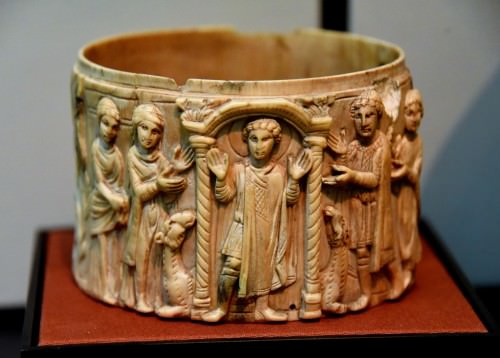
Ivory Pyxis Depicting Saint Menas
The city became steadily impoverished after the rise of Christianity, both financially and culturally, and became increasingly a battlefield for warring faiths. It was conquered by the Sassanid Persians in 619 CE. The Christian Byzantine Empire under Heraclius re-claimed the city in 628 CE but lost it to the invading Arab Muslims under Caliph Umar in 641 CE. The forces of the Christian Byzantines and the Muslim Arabs then fought for control of the city, and Egypt, until the Arabian forces prevailed in 646 CE and Egypt fell under Islamic rule. The churches were now destroyed or transformed in mosques and Christian legend claims that it was at this time that the great library was burned by the Muslim conquerors.
What was not destroyed by war was taken down by nature and, by 1323 CE, most of Ptolemaic Alexandria was gone. The great lighthouse was steadily destroyed by earthquakes as was much of the port. In 1994 CE the first discoveries were made known of a number of relics, statuary, and buildings in the harbor of Alexandria. These have been steadily excavated by Professor Jean-Yves Empereur and his team who continue to bring to light the lost golden age of Alexandria.
MAP
LICENSE:
Article based on information obtained from these sources:with permission from the Website Ancient History Encyclopedia
Content is available under License Creative Commons: Attribution-NonCommercial-ShareAlike 3.0 Unported. CC-BY-NC-SA License